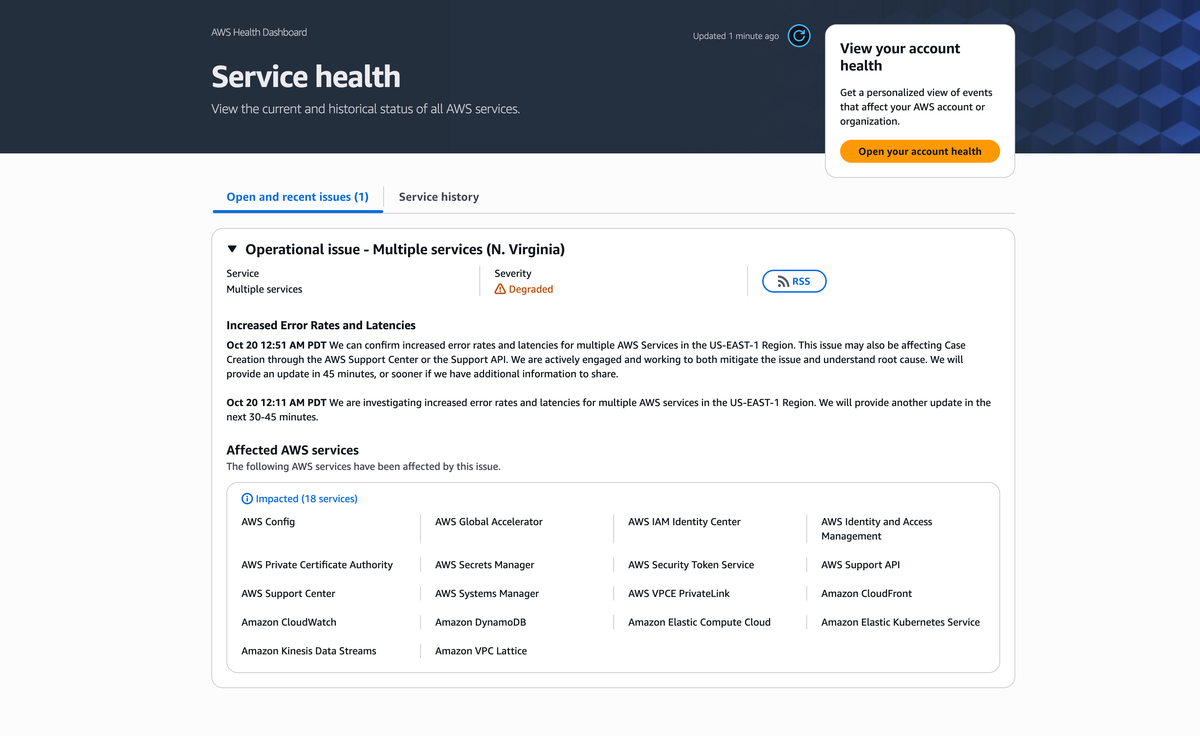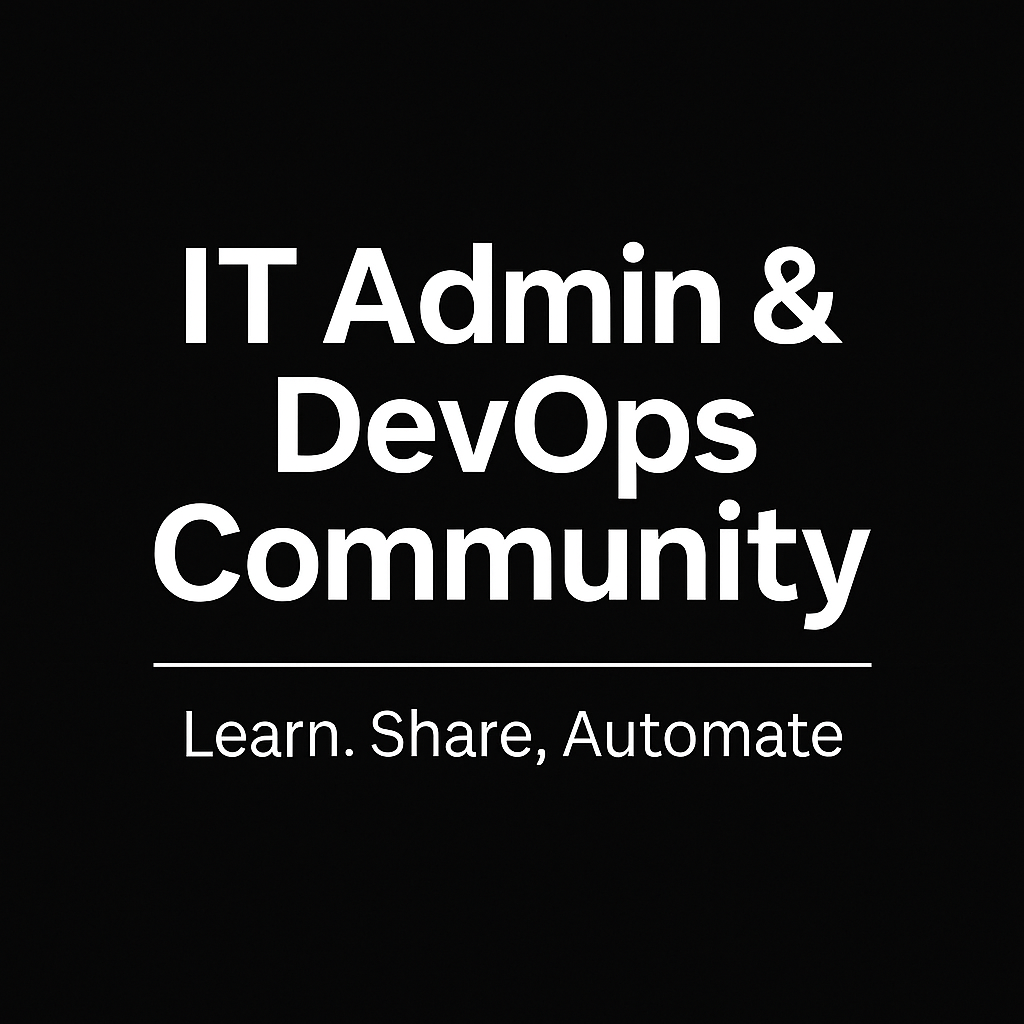⚠️ AWS Outage in US-EAST-1 Region: Increased Error Rates and Latencies Impact Multiple Services
Amazon Web Services (AWS) is currently facing a major outage in the US-EAST-1 (N. Virginia) region, causing increased error rates and latencies across multiple services including EC2, CloudWatch, and DynamoDB.

Date: October 20, 2025
Region Affected: N. Virginia (US-EAST-1)
Status: Degraded Service
Amazon Web Services (AWS), the world’s largest cloud infrastructure provider, is currently experiencing a major operational issue in its US-EAST-1 (N. Virginia) region — one of its most critical and high-traffic data centers. According to the official AWS Service Health Dashboard, multiple AWS services are reporting increased error rates and higher-than-normal latencies, with engineers actively investigating the root cause.
🔍 What’s Happening: Increased Error Rates and Latencies
As of 12:51 AM PDT, AWS has confirmed that multiple core services are impacted, including CloudWatch, DynamoDB, EC2, IAM, and CloudFront. Users and developers have reported issues with API timeouts, delayed responses, and difficulty accessing AWS Support or creating new cases through the AWS Support Center.
AWS has stated:
“We can confirm increased error rates and latencies for multiple AWS services in the US-EAST-1 Region. Our teams are actively engaged and working to both mitigate the issue and understand the root cause. We will provide an update in 45 minutes, or sooner if we have additional information to share.”
This statement reflects AWS’s typical communication pattern during major service degradations — continuous investigation, frequent updates, and global transparency via their Service Health Dashboard and RSS feeds.
⚙️ Affected AWS Services
The following 18 AWS services are currently listed as impacted in the US-EAST-1 region:
- Amazon CloudWatch
- Amazon CloudFront
- Amazon DynamoDB
- Amazon Elastic Compute Cloud (EC2)
- Amazon Elastic Kubernetes Service (EKS)
- Amazon Kinesis Data Streams
- AWS Config
- AWS Global Accelerator
- AWS Identity and Access Management (IAM)
- AWS Private Certificate Authority
- AWS Secrets Manager
- AWS Security Token Service (STS)
- AWS Support API
- AWS Support Center
- AWS Systems Manager
- AWS VPCE PrivateLink
- Amazon VPC Lattice
This list includes several core infrastructure components, meaning the outage could affect application performance, CI/CD pipelines, API requests, and even third-party SaaS integrations that depend on AWS’s global backbone.
🌎 Why the US-EAST-1 Region Matters
The N. Virginia (US-EAST-1) region is AWS’s oldest and most widely used data center region. It hosts an enormous volume of workloads — from startups and enterprise SaaS platforms to major Fortune 500 companies.
Historically, this region has also been a single point of failure for global AWS operations. Major outages in US-EAST-1 often ripple across the internet, temporarily disrupting services like:
- Netflix
- Slack
- Robinhood
- Amazon.com retail
- Third-party authentication systems (OAuth integrations, SSO)
Given its scale, even small disruptions in US-EAST-1 can have cascading effects on other AWS regions and dependent applications worldwide.
🚨 Potential User Impact
Developers and businesses using AWS may currently observe:
- Slower API responses
- Increased timeout errors
- Delayed Lambda invocations
- Connectivity issues in private VPC endpoints
- Inability to access AWS Support Center or open new tickets
- CloudWatch monitoring and alerting delays
If your application or cloud environment is hosted in US-EAST-1, you should avoid deploying or scaling workloads until AWS declares full service restoration.
🧠 What You Can Do Right Now
- Monitor AWS Health Dashboard:
Stay up to date at https://status.aws.amazon.com/. - Avoid Major Changes:
Refrain from modifying EC2 instances, updating Lambda functions, or deploying via CI/CD pipelines. - Use Multi-Region Architectures:
Consider deploying critical workloads in secondary regions (like US-WEST-2 or EU-WEST-1) for redundancy. - Enable Fallback Systems:
Implement failover DNS routing or multi-cloud strategies using Cloudflare, GCP, or Azure for high availability. - Check Third-Party Dependencies:
SaaS tools like Datadog, GitHub Actions, or Jenkins may also show degraded performance if hosted on AWS infrastructure.
📊 Historical Context: AWS Outages in US-EAST-1
The US-EAST-1 region has faced several notable outages in the past decade:
- December 2021: Massive outage affected Amazon Prime Video, Alexa, and Ring.
- November 2020: Kinesis Data Streams incident caused cascading failures.
- June 2023: Short-term DNS failure disrupted EC2 and RDS operations.
Each event highlights the need for distributed system design, multi-region failover, and robust incident response playbooks.
💬 AWS’s Ongoing Response
AWS engineers are currently working to mitigate the issue and restore normal operation. They’ve promised to issue another update within 45 minutes or sooner if new findings arise.
While no ETA for full resolution has been provided yet, users can expect AWS to deliver detailed root cause analysis (RCA) once the issue is resolved.
🔄 Update – October 20, 2025 – 12:26 AM PDT
AWS has confirmed significant error rates for requests made to the Amazon DynamoDB endpoint in the US-EAST-1 (N. Virginia) region.
This disruption also impacts other AWS services in the same region, including support case creation through both the AWS Support Center and the Support API.
AWS engineers have been actively engaged since the initial reports, working to mitigate the issue and fully understand the root cause.
According to the latest official statement, AWS expects to provide a further update by 2:00 AM PDT, or sooner if new information becomes available.
The severity level has been escalated to Disrupted, with Amazon DynamoDB officially listed as the primary affected service.
🧩 Affected AWS Services (as of 12:26 AM PDT)
- Disrupted: Amazon DynamoDB
- Impacted (26 services):
AWS Config, AWS IAM Identity Center, AWS Secrets Manager, AWS Systems Manager, Amazon CloudWatch, Amazon FSx, Amazon Q Business,
AWS Database Migration Service, AWS Identity and Access Management, AWS Security Token Service, AWS VPCE PrivateLink, Amazon Elastic Compute Cloud,
AWS Elemental, AWS Network Firewall, AWS Support API, AWS Support Center, Amazon API Gateway, Amazon CloudFront,
AWS Global Accelerator, AWS Private Certificate Authority, Amazon Elastic Container Registry, Amazon Elastic Kubernetes Service,
Amazon Interactive Video Service, Amazon Kinesis Data Streams, Amazon Polly, Amazon VPC Lattice.
🕐 Next update expected: by 2:00 AM PDT (October 20, 2025).
🧭 Conclusion
The ongoing AWS US-EAST-1 outage once again highlights the importance of resilient cloud design and multi-region redundancy. No cloud provider is immune to failure, and every incident is a reminder that preparation is key.
As AWS works to restore full functionality, users should take this as an opportunity to review disaster recovery strategies, improve monitoring, and build redundancy into mission-critical systems.
If you want to learn more about cloud technologies, programming, and IT systems, visit 👉 dargslan.com — your place to grow your technical skills with expert-level books and learning resources.
Tags: AWS outage, AWS Service Health Dashboard, US-EAST-1, Cloud Computing, EC2, CloudWatch, DynamoDB, AWS latency, AWS downtime, AWS region failure, cloud reliability, AWS infrastructure, cloud architecture.




